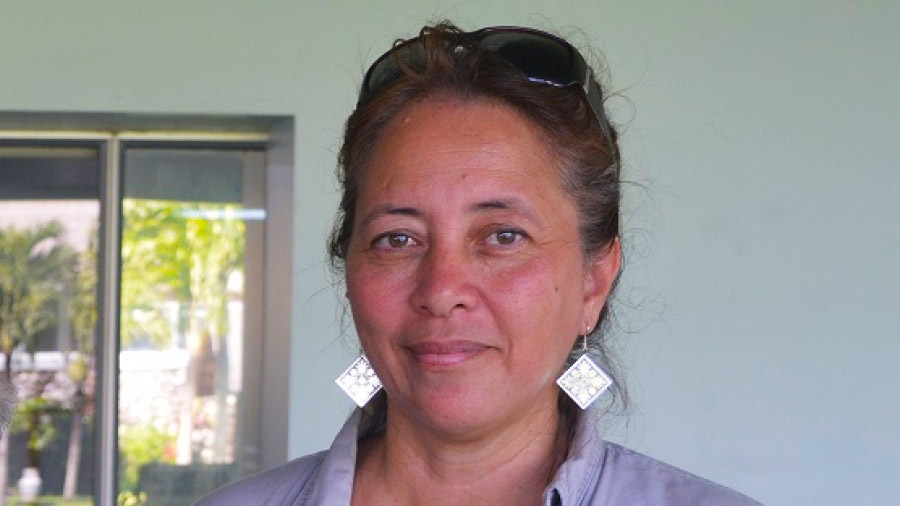A little piece of Cook Islands in Israel
Thursday 2 December 2021 | Written by Supplied | Published in Editorials, Opinion

Jean Mason. SUPPLIED
The ‘Lord’s Prayer’ in Cook Islands Maori is one of the latest additions to the colourful ceramic mosaic plaques at Church of Pater Noster in Israel. By Jean Mason of the Cook Islands Museum and Library Society Inc.
The Mount of Olives, known in Arabic as Jabal al Tur, and in Hebrew as Har ha-Zeitim, is a multi-summit limestone ridge just east of the old city, Jerusalem, and separated from it by the Kidron Valley.
Frequently mentioned in the Bible and in later religious literature, it is holy to Judaism, Christianity and Islam. It is first mentioned in the Bible at 2 Samuel 15 and in the Book of Zechariah.
Located on the Mount of Olives is the church of the Pater Noster (Latin for Our Father). This church is the third built on top of Constantine’s earlier Byzantine church, called Eleona, which had been destroyed by Persians in 614. The Crusaders rebuilt it in the 12th century but it was heavily damaged by the armies of the Muslim Sultan Saladin only 38 years later.
In 1868 a cloister was built and in 1872 a Carmelite convent was founded on the site of the church. By this time the Carmelites were to be found in many parts of the world but the orders, founded by Berthold of Limoges, and originally goes back 971 years.
It is to this site that, at Easter 2019, three Cook Islands residents – Theresa Noovao, Teresia Purea, and the writer (Jean Mason) – had the privilege of visiting with their able guide, Father Tony Dunn, S.M.
One of the busiest tourist sites in Israel, the pathways to Pater Noster were packed with people from all over the world, but what I remember most are the happy faces of the gorgeous Ethiopians all dressed in white. It was a true United Nations.
A long tradition holds that Jesus taught the Lord’s Prayer (or Our Father) in the cave that forms the grotto under the remnants of the Byzantine church and what grabbed our attention was the colourful ceramic mosaic plaques heralding the “Lord’s Prayer” in many languages of the world.
I noticed the Pacific was well represented with the Lord’s Prayer in Papuan, Samoan, Tahitian, Fijian, New Zealand Maori, and Hawaiian. We looked through the cathedral, the cloisters, and the wall outside but nowhere could we see our country represented.
Father Tony Dunn encouraged me to do something about this and I managed to get a contact from one of the French-speaking sisters who ran the property. The request had to be sent through the Catholic Bishop.
On return to the Cook Islands, I contacted Sister Elizabeth Browne-Russell, who was happy to organise this. Over the next two years, Sister Elizabeth drafted correspondence and sent it to Sylvie Kirsch for translation into French, before it was conveyed to the Carmelites. Soon we had a ‘go to’ being Sister Anaywah who explained what we had to do.
The mosaic tiles are handmade in Israel and our job was to get the funds and get the right wording. The rules were strict. We had to send the Cook Islands Maori version of the liturgical Lord’s Prayer used in Roman Catholic services.
It is to the late Henrica Wilson Marona and George Paniani we owe the work to ensure the accuracy of the text and it is to some dedicated Catholics and supportive Protestants and other kindly, community-minded persons, both here and overseas, that we owe the ability to fund this project. Our grateful thanks to them all.
Covid-19 caused delay as did the resumption of hostilities between Israel and the Palestinians in the Gaza Strip and West Bank which led Arabs in Israel to call a general strike. But Sister Elizabeth was finally notified on 22 October, 2021 by Soeur Anaywah, of the Monastère Carmel du Pater Noster that the plaque was complete.
So, when you visit Israel or the next time you visit Israel, take the chance to head to the Pater Noster Church, Mount of Olives, and visit an outpost of the Cook Islands language and a symbol in the Holy Land of the fact we embraced the Christian heritage two hundred years ago.














































